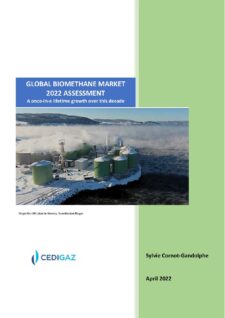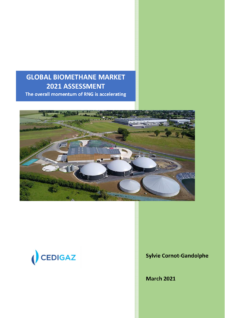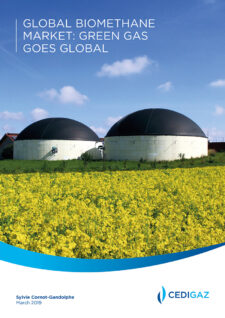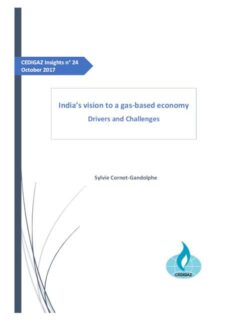
GLOBAL BIOMETHANE MARKET 2022 ASSESSMENT + DATABASE
| Non Member | 1850 € | |
| Member | FREE | Login |

GLOBAL BIOMETHANE MARKET 2021 ASSESSMENT (Report and Database)
| Non Member | 1770 € | |
| Member | FREE | Login |
This report updates the 2019 CEDIGAZ’s comprehensive study on global biomethane (also known as renewable natural gas, RNG). It focuses on biogas upgrading and looks at key developments in the marketplace, policies, and major markets. Global RNG production reached 4 bcm in 2019, a doubling since 2015. There are now close to 1,000 biogas upgrading plants operating in the world. The market remains dominated by Europe (2.4 bcm), but the United States is catching up rapidly and, in fact, has become the world’s leading producer (1.1 bcm), ahead of Germany. In other regions, biomethane production is still limited (0.4 bcm collectively), but the market is taking off in Brazil, Canada, China and India. Recent years have seen significant shifts in terms of key sources of demand and market drivers. Hard-to-abate sectors (road transportation, shipping, heat) are becoming the focus of support policies, while cost reduction in wind and solar power generation makes the use of biomethane in the power sector less attractive, except for providing flexibility. RNG is more and more recognized for its key role in decarbonizing and bringing sustainability in the agriculture and waste sectors and is increasingly included in climate policies targeting these sectors.

GLOBAL BIOMETHANE MARKET 2021 ASSESSMENT (Report)
| Non Member | 990 € | |
| Member | FREE | Login |
This report updates the 2019 CEDIGAZ’s comprehensive study on global biomethane (also known as renewable natural gas, RNG). It focuses on biogas upgrading and looks at key developments in the marketplace, policies, and major markets. Global RNG production reached 4 bcm in 2019, a doubling since 2015. There are now close to 1,000 biogas upgrading plants operating in the world. The market remains dominated by Europe (2.4 bcm), but the United States is catching up rapidly and, in fact, has become the world’s leading producer (1.1 bcm), ahead of Germany. In other regions, biomethane production is still limited (0.4 bcm collectively), but the market is taking off in Brazil, Canada, China and India. Recent years have seen significant shifts in terms of key sources of demand and market drivers. Hard-to-abate sectors (road transportation, shipping, heat) are becoming the focus of support policies, while cost reduction in wind and solar power generation makes the use of biomethane in the power sector less attractive, except for providing flexibility. RNG is more and more recognized for its key role in decarbonizing and bringing sustainability in the agriculture and waste sectors and is increasingly included in climate policies targeting these sectors.

Oil and Gas Majors in India: Co-creating the Gas and LNG Market
The entry of big players into the downstream gas market, in partnerships with strong Indian partners, offers a key leverage to the Indian vision to realise a gas market-based economy. They can deliver competitive and affordable LNG supplies and accelerate gas infrastructure build out, thus solving two key bottlenecks on the Indian gas market. Energy majors will facilitate and accelerate gas market growth and enlarge the gas market with innovative solutions adapted to Indian conditions. A larger gas sector augurs well with Indian economy as well as for the environment and is a win-win situation for all stakeholders.
While the COVID-19 crisis has introduced an additional uncertainty to natural gas demand growth, the Indian gas market fundamentals are robust and long-term growth propects remain strong.
Global biomethane market: Green Gas Goes Global
| Member - unlimited online access | 500 € | Login |
| Non member - 5 licenses | 2500 € |
This report provides a detailed analysis of the booming biomethane market as governments around the world increasingly recognize the many benefits of renewable natural gas.
Since 2010, world biomethane production has increased exponentially, reaching three billion cubic meters in 2017 and there will soon be more than 1,000 biomethane production plants operating in thirty-four countries, up from 720 at year-end 2017.
For many years a European phenomenon, Green Gas is Going Global.
The report contains three parts:
- An overview of global biomethane production and markets, biogas upgrading plants, key drivers and future trends (region by region)
- Country reviews for forty countries in Europe, North America, Asia, Central & South America and Africa
- In-depth case studies on key developed and emerging biomethane markets, e.g. U.S., Canada, Brazil, Germany, France, China and India.
It complements the CEDIGAZ Global Biomethane Database

The Future of Natural Gas in China and India - Critical Drivers and Challenges




